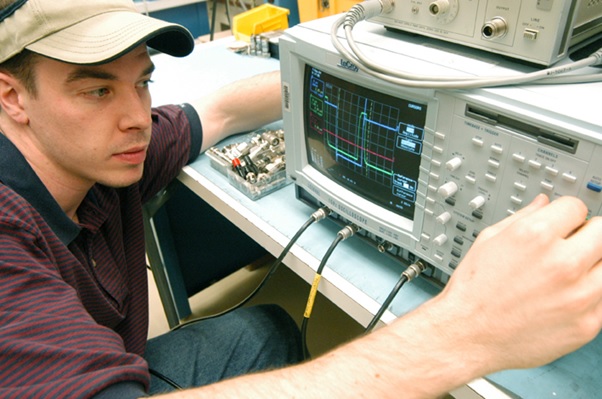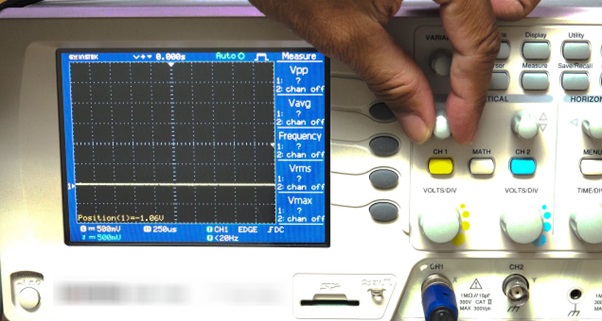An oscilloscope is a high-end voltage measurement device that can show you the deepest secret of voltage in electric current. It shows you how every component works on an electrical device.
Generally, the oscilloscope takes the electrical voltage measurement into consideration, processes it, and shows the result graphically in the display. You must be wondering what makes it different from a multimeter because it also measures AC and DC voltage and many more, right?
In all honesty, the multimeter is overall a good electrical measurement device, however, it doesn’t just show the voltage count measurements. Whereas the oscilloscope shows every detail related to that measured device just by measuring the voltage.
How Does An Oscilloscope Work?

In an electrical circuit, the DC voltages are changing in seconds not minutes. The oscilloscope picks up the electromagnetic noise and measures the voltage changes over time, with that it plots a graph to understand the behavior of the voltages.
A typical oscilloscope plots the voltages changes in time every nanosecond to calculate and provide the best possible result for you. You can see the energy out from the electrical circuit on its display.
Why Use An Oscilloscope Instead Of A Multimeter?
You must be wondering why not use a multimeter, not only does it help you measure the electrical circuit, but also comes at a cheaper rate, right? With all honesty, that assumption couldn’t be more wrong.
Yes indeed, comparatively oscilloscopes come at a higher price than multimeters. However, the number of details you get from an oscilloscope under 500 dollars, is quite remarkable, and it’s worth every penny.
Sometimes while conducting research or taking measurements on an electrical circuit board, you need accurate data which a multimeter can’t provide. In such cases, a scope is a perfect tool for measuring every ounce of data.
Also, with a multimeter sometimes it’s harder to pinpoint the exact measurement voltage measurement. Whereas the oscilloscope takes the voltage details into consideration and measures them by the seconds to provide exact output.
Considerable Factors While Choosing An Oscilloscope
Scope gives you the best voltage measurements. However, while choosing one for yourself you should consider a few factors depending on your usage. Because it’s just a machine it will do what it was meant to do.
If you don’t choose right, you won’t get the accurate result you desire. If you consider these given factors below, it’ll be easier for you to choose the right scope for your electrical voltage measurements.
Analog Or Digital
As you know, oscilloscopes come in two forms: analog and digital. Comparatively analog scopes are a simpler form of an oscilloscope, but they tend to be heavy and bulky, which leads to hinder the portability ratio.
However, the digital scopes are much lighter and provide better portability. Also, it can provide the voltage measurement result much faster and more accurately.
As these units come with better bandwidth capacity. Not only that, the digital units are much easier to read than the analog units.
Bandwidth
An oscilloscope’s bandwidth capacity is what provides you with accurate voltage data. Higher bandwidth means its result capabilities will be more accurate.
Because with high bandwidth, a scope can take more data into consideration which leads to a better probability ratio. So it’s a good idea to get a higher bandwidth ratio scope than you need.
You should get a 5 times higher bandwidth ratio if you get the digital one and a 3 times higher if you get the analog one. It should provide you with accurate data no matter which one you choose.
Sample Rate
Sample rate refers to the waveform you see on the scope’s display panel. Generally, the sample rate is what the scope measures data from the voltage in GS/MS per sec.
Two times higher than the frequency rate should be enough for the sample rate on your scope.
Channels
How many channels ranges your oscilloscope has, determines the signal’s multitasking capabilities. An oscilloscope analyzes voltage through channels. More than 3 channel range allows your scope to simultaneously analyze several voltage data at once.
If you deal with electrical circuits on a regular basis, the scope of 4 channels should be enough.
User Friendly
Oscilloscopes make circuit analysis easier, right? But it’s only true if you understand what it’s analyzing. Otherwise, there’s no point in having one. You should get the one that comes with built-in instructions.
Also, the display should be clear so that you can easily read the waveform of measured data circuits.
How To Measure DC Voltage With The Oscilloscope?
Now that you have your ideal oscilloscope for voltage measurements. Just so you know, you can use the scope to measure DC (Direct Current).

However, it’s a lengthy process. So let’s show you how you can measure the DC voltage with the oscilloscope. To do that follow the given instruction below to DIY.
- Turn on the oscilloscope.
- On the right side of the scope, you see different buttons in the panel. Find and select the AUTO
- Then on the display, you’ll see two sections, horizontal and vertical. You’ll need to tweak it manually.
- For the horizontal section, set the dial with MAIN TIME/DEV to 0.1ms
- In the vertical section, from the two switches select the dual channel. Then, in the CH1 select the DC voltage.
- Also, turn the channel 1 knob to 1 voltage. Then adjust the channel’s position according to the knob.
- Do the same for CH2 and after that locate the scope’s probe switches. Tweak them x1.
- Now with the probes, you can measure the DC voltage. First, connect it to the electric circuit board, and then connect the probe’s BNC connector to the scope.
- Then the oscilloscope will start measuring the DC voltage from the circuit board. You can see the measurement fluctuation on its display.
Last Words
An oscilloscope is a reliable tool for voltage measurement and is unrivaled in its field. With it, you can also measure the frequency and amplitude from the circuit board.
If you’re looking for a tool to measure the DC voltage on your electrical system, then the oscilloscope is perfect. You can do that just by following the above-mentioned instructions and getting accurate results.
I really liked your review. With your permission, I would like to share it on my social media accounts. I will cite the source. Thank you.
You may share but kindly give credit to us.
Great post!
I’m just wondering if you have any recommendations on how to avoid attenuation or overshoot?
Thanks!
Hi,
I need an active email address or phone number to send couple of RFQs.
thanks